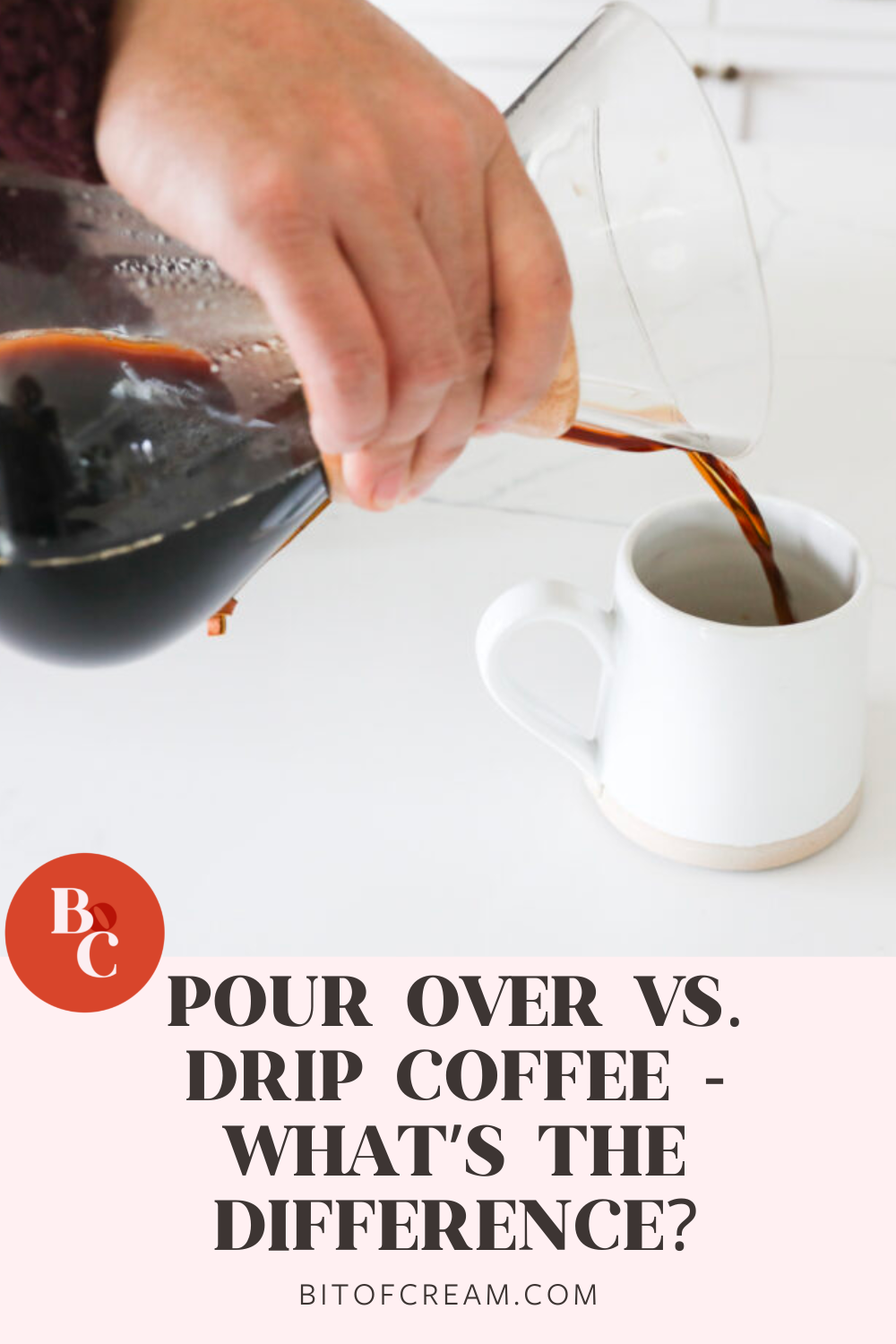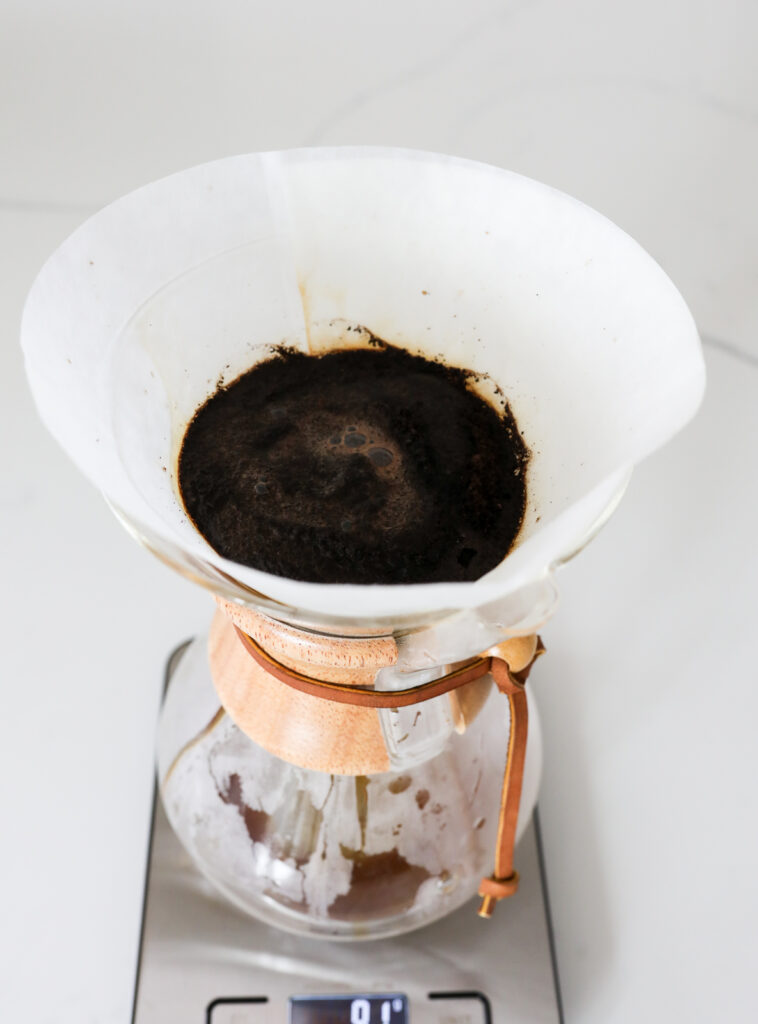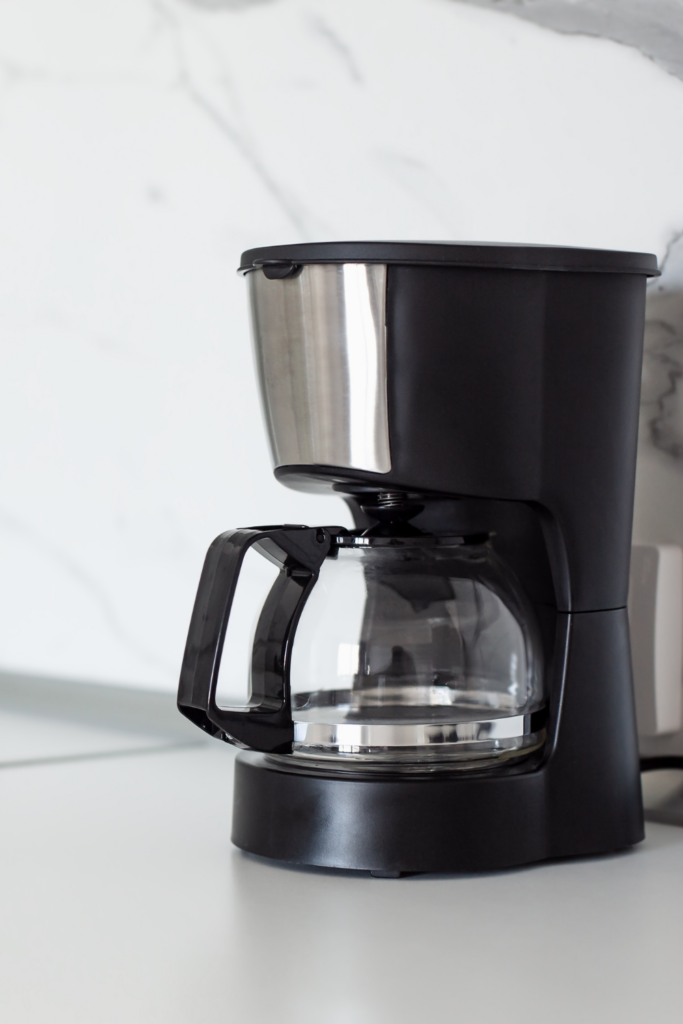Why would you go to the effort of pour over brewing when it’s basically the same thing a drip machine does? After all, a drip machine is a no hassle set it and forget it device.
For many coffee pros, like me, the decision ultimately comes down to control.
Yes, you can make a reliable and delicious cup with either method. But there are tradeoffs.
In this article, I’ll explain the mechanical differences between pour over vs. drip coffee brewing. And I’ll highlight the benefits and drawbacks of either method.
Ultimately, I want to leave you with a clear perspective on which option is a better choice for your situation!

What is Drip Coffee?
Drip is an automatic method of brewing coffee. It’s probably the most popular way people get their daily dose in North America.
Why? It’s convenient and nearly foolproof.
Drip coffee is brewed using a dedicated machine, like a Mr. Coffee. With the push of a button, you can have half a dozen servings ready in about 10 minutes.
A drip machine heats water in a rear boiler compartment. The hot water is pumped to an extraction chamber, where it sprays or drips out of a nozzle. Gravity pushes the droplets across a basket of ground coffee, through a filter, and ultimately into a large carafe below.
Drip is great when you want a clean, balanced brew. Or if you’re serving multiple people. Also, if you’re really, really tired.
What is a Pour Over?
Pour over is another brew method that uses gravity to pull water across ground coffee. Like a drip machine, this is where flavor extraction happens.
Unlike a drip machine, a traditional pour over is manual, with no moving parts.
In this method, hot water is poured over freshly ground coffee.

The coffee is usually nested inside a conical paper filter. Water passes through the coffee, then a filter, and into a receptacle. This could be a small mug or a large carafe.
You could say that pour over is essentially drip coffee, except that the human has all the control. This means that often the results are more flavorful.
Differences between Pour Over and Drip Coffee
Flavor Profile
Drip is your reliable friend. You and drip go way back.
With mild adjustments to your grind or coffee-to-water ratio, a cup of properly brewed, classic drip is smooth sailing. The presence of more specific flavors will always depend on the coffee you are using.
The same goes for pour over. When brewed properly, pour over has a smooth body like a clean cup of drip, but the method has the potential to reveal more specific flavors.

For example, a medium roasted cup of Ethiopian coffee can taste great on drip with chocolate and subtle berry notes. That same coffee dialed into a pour over can have a rich body with the same chocolate sweetness, plus the presence of blueberry and/or raspberry.
Again, the results vary greatly; it all depends on the coffee you use and how much you’re willing to experiment. But baristas love their pour overs for a reason: more control, more dialed extraction, and more opportunity for flavor.
Mouthfeel
The texture of both brew methods is smooth and clean.
What does that mean? If you’ve ever tried french press coffee, think of the opposite. French Press is much heavier, sometimes to the point where it feels like you could chew it.

The precise mouthfeel depends on brew time, grind size, dose, and water temperature. It’s a balance.
With a drip machine, many of those variables are fixed. The machine simply does what it does. With pour over, you gain some flexibility to alter the process. And, therefore, the result.
Extraction Method
Both drip and pour over use a gravity-based extraction method.
This is different from, say, espresso. In that method, steam is forced at high pressure. It also differs from French Press, where coffee extraction is based on immersion.
The key characteristic of gravity extraction is that water passes through the coffee. And only once. This means that new water makes contact with the ground coffee throughout the process.
With a pour over, you can “bloom” the coffee first. Most drip machines aren’t equipped for this step.
“Bloom” is the process of saturating ground coffee with hot water. Just not enough so that water passes through the paper filter. This step releases flavorful oils from the beans before the actual pouring begins.
Thus the procedural difference between drip and pour over.
Grind Size
Both methods use a medium-coarse or coarse grind setting. This is essential so that the water can pass through the coffee at the proper speed.
Start with the manufacturer’s prescribed grind setting when grinding your own coffee. BUt if you don’t have a grinder handy, use this expert coffee grind guide that gives you techniques on how to grind coffee without a grinder!
Grind size is intimately entwined with extraction time. If the water takes too long to pass through the coffee, you will likely end with a bitter cup due to over-extraction.

This is a common side effect of using grinds that are too fine. Over-extracted coffee may also come across as ashy or burnt.
Similarly, large-diameter coffee grounds can cause problems. If your coffee tastes salty or medicinal, that’s probably the case.
Water passes too quickly through an oversized grind. This leads to under-extraction.
If you notice any of these symptoms, adjust accordingly.
Dose Ratio
A dose ratio describes the amount of water you should use during brewing for every part of ground coffee. It’s measured by weight.
- For pour over, start with a 15:1 ratio.
- For drip, start with a 17:1 ratio.
While these are excellent starting points, listen to your palate and adjust accordingly. As a pro barista, I learned that the “best” dose ratio always changes.
Dose changes are mostly a product of the type and age of your coffee. The ratio that worked well on Friday might need an adjustment by Monday morning. This is because the chemistry of coffee changes as it ages.
I’d always recommend using a digital scale if you can.
Time
Timing is an important factor in extraction. And it’s also a practical consideration as to which brew method is best for your situation.
I prep my personal coffee in a studio apartment, so I don’t have room for a drip machine. At the same time, the hands-on time it takes to prep pour over can be frustrating. Especially if I’m in a rush.
The pour-over process can take 5-7 minutes with some practice. Not every moment is hands-on, but you can’t set it and forget it like a drip machine.

Waking up and pressing a button on your automatic drip system sounds like a seamless way to wake up. Get dressed while the coffee brews, and you’re good to go.
It all depends on how much time you spend preparing your perfect cup.
Drip will always be the simpler option if you’re making coffee for three or more people in the morning.
Caffeine
Caffeine levels fluctuate depending on your brew ratio and the coffee itself. The higher your coffee-to-water ratio, the higher the levels of caffeine.
Think of espresso: it’s only a couple of ounces of liquid. But at 18.5-22 grams of coffee per dose, it really packs a punch. That’s because it’s brewed at a highly concentrated water ratio to coffee.
The caffeine levels of pour over or drip operate the same way. One can always be “stronger” than the other. It all depends on your dose ratio.
Equipment
Pour over requires a pour over cone (or Chemex) paper filters, a scale, and a kettle with a restricted pour.
Be sure to find a scale with a built-in timer for efficiency. It’s also helpful to have an electric kettle with a restricted pour for ample pouring control.
Drip machines come in all colors, shapes, and sizes. Some are more efficient than others at heating and dispersing water appropriately.

Pro tip: Check how the water is dispersed before you purchase a drip machine. Open the lid. You’re looking for a spout that looks like a showerhead. Not just a few concentrated holes that will only saturate some of the coffee.
Origins
The first drip and pour-over were invented in Germany.
In 1908, a woman named Melitta Bentz (yes, that Melitta) was disappointed in the flavor of her percolator coffee. She took a page from her son’s textbook and used it as a filter. Hence, the pour over as we know it today.
Melitta’s use and later patent of the paper filter inspired the first electric drip machine. It was invented by Gottlob Widmann.
FAQ
The answer is yes and no. Both methods include hot water, a paper filter, and freshly ground coffee. Pour over is a more fine-tuned, controlled version of drip. The home brewer or barista manually adds water to coffee in controlled intervals in this method. With drip, we measure and grind the coffee and leave the rest up to the machine.
There is no clear-cut answer. The average water-to-coffee ratio for pour over is 15:1, and the average ratio for drip is 17:1, making pour over coffee the more caffeinated choice. It all depends on how strong your water-to-coffee ratio is, which can vary from coffee to coffee as you search for the perfect extraction ratio.
Technically yes, but “special” does not have to mean “expensive.” There are many different types of pour over cones, from Chemex to Miir or Melitta.
Coffee scales with built-in timers are exceptionally affordable. Paper filters are typically sold in packs of 100 or more. They’re very affordable, although Chemex-specific filters can cost more. An electric kettle might be the more expensive purchase since a kettle with a restricted pour is so important for proper extraction.
Want weekly coffee tips and tricks, recipes and more?
Put your email in the box below and you’ll not only get added to our list but you’ll also get 3 free recipe cards (Colada Coffee, Mocha and Spanish Latte) delivered right to your inbox!
